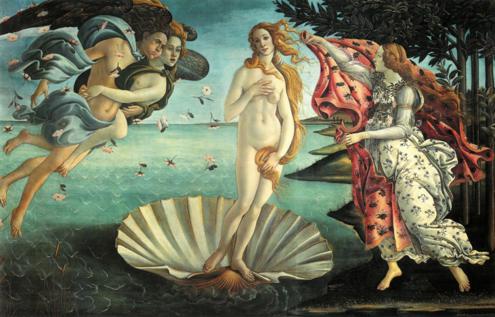Sandro Botticelli, with a birth name of Alessandro di Mariano Filipepi, was born on May 17, 1510 at Florence, Italy. But recounting the early life of this great portraitist is very insufficient as his historical accounts are few. However, Sandro Botticelli was known to have become an apprentice at the age of fourteen (14); his apprenticeship earned him a full education as compared to other Renaissance artists who were not able to finish school. He was also trained as a goldsmith by his brother, Antonio. In 1942, Botticelli became an apprentice painter to Fra Filippo Lippi, with his early works accredited to this master. Botticelli was influenced by the paintings of Masaccio, also a great painter of the Italian Renaissance, but Sandro learned making intricate details from his master painter, Fra Filippo Lippi. Since then, Botticelli travelled to Hungary for more painting endeavours; even an archbishop of Hungary, in the person of Vitéz János, came to love Botticelli’s painting.
Sandro Botticelli was indeed a master of Renaissance art. In 1486, he created a masterpiece painting entitled “The Birth of Venus”, which depicts the goddess Venus or Aphrodite in Greek Mythology. As seen on the painting, Venus emerges from the surface of the sea with a giant shell that added perfection to the picture. The Zephyr wind-gods lead Venus to the shore with roses showering down upon her, symbolizing spiritual passion. As Venus is surfacing on the shore, the Nymph hands her a purple cloak. This uniqueness and spirituality of this painting are the reasons why it is considered a genuine Renaissance masterpiece.
During this era when most paintings were influenced by Christian beliefs figures of women symbolize chastity, Botticelli came up with an idea to choose Venus as his main character in his painting; and he painted it nude. Because he had an influential friendship with the Medici family, then a strong political dynasty in Florence, this rather provocative painting was saved from any religious critic and indignation. But Botticelli’s other paint works were condemned and perished in flames because of their pagan themes.
Many of Botticelli’s paintings interpret a moving concept. His “The Birth of Venus” painting was influenced by a painting of another masterpiece painter named Apelles. The title of Apelle’s painting was “Venus Anadyomene”, from the word “Anadyomene”, which means rising from the sea. The way Venus posed in Botticelli’s painting also resembled Venus di Medici, a marble statue of classical antiquity which he had an opportunity to study.
The Birth of Venus painting of Botticelli rejects the classical realism of Raphael or da Vinci. The figure of Venus foreshadows mannerism which is obviously depicted in the painting where Venus covers the sensitive part of her body. Venus is obviously a fantasy image as the painting shows an improbable pose of Venus, when done realistically Venus’ posing is likely to be anatomically impossible to do. Botticelli’s choice of character lacks in giving weight and volume that he rarely puts deep perspective in space per se.
Though the painting was a pigment of his imagination, it still gave curious ideas to his audiences as to how the painting was influenced or what manifestations it was trying to convey. Despite the fictional ideas of “The Birth of Venus”, the painting surely presented a pleasurable sight to its viewers and certainly influenced the minds of the other great portrait painters in history as well.
Author: Shyxter
